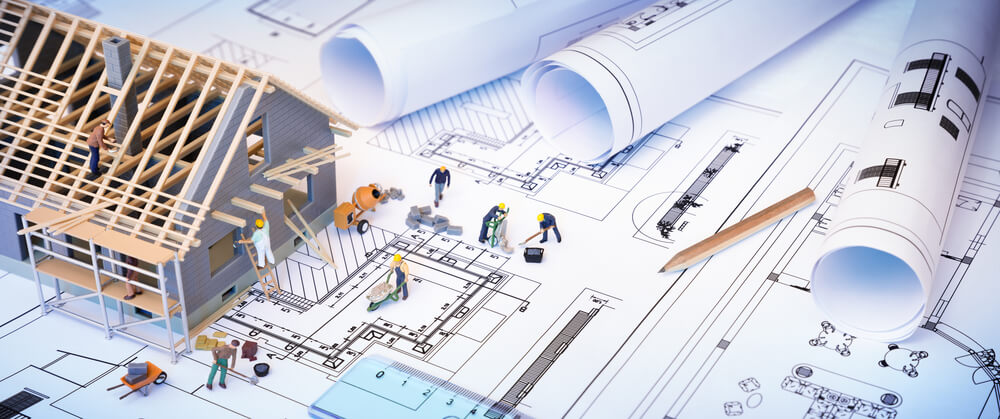Building a house is a great opportunity. Essentially a blank canvas, you can design a space to your exact wants and needs. Importantly, you also have the opportunity to infuse the home with your style and personality. Culminating in the creation of something uniquely your own.
However, as the process of building a house starts with a blank canvas, there is a lot of work to be done. In fact, that blank canvas has to transform into a functional, inhabitable property while adhering to time constraints, building regulations and a budget.
As such, there are many stages to the building process. Therefore, before embarking upon the process, it’s important to be aware of each stage. This way, you can ensure that you have all the necessary information and tools to proceed as seamlessly as possible.
Stage 1: Pre-construction
The first stage of building a house is pre-construction. An all encompassing stage, pre-construction essentially involves outlining everything from design and construction plans to choosing a builder and finalising your budget.
While there are a lot of facets to pre-construction, it’s important to take it step by step. It can be tempting to rush through the project in order to break ground on site. However, the planning stage, when done properly, can lay the foundation for a successful build.
Concept development
Designing a house from scratch is a big responsibility. You will be responsible for advising the positioning of the front door, the number of bedrooms and what to do with dead space under the staircase or near the entrance.
One of our Kitome Consultants can help you through this process. During an initial design consultation, you can sit down with one of our consultants and identify your needs and wants. Create the base of your dream home design with complete design flexibility, using one of over 30 designs or designed from scratch.
From there, our internal design team will turn this base into a formalised floor plan, complete with corresponding elevations. With the ability to make changes, you can change the number of bedrooms, or the size of the master ensuite.
Costing and financing
Armed with a floor plan, the next element of pre-construction is working out the associated cost and therefore the budget you can comfortably adhere to. Balancing finances can feel stressful and overwhelming. A consultant at Kitome can provide assistance.
Choosing a builder
Once your budget is formalised, it’s time to choose the builder who will turn your dream home plans into a reality. As a builder will be responsible for building your house, they need to meet a variety of different criteria.
Firstly, it’s important to view a project portfolio and also hear from references. When hiring a builder, you want an expert in the style of home you are aiming for. Secondly, it’s advisable to choose a builder who you feel you can communicate with.
Oftentimes, aspiring home builders and their builders will need to have tough conversations. If you feel intimidated by your builder, you won’t want to approach them to enquire about the project timeframe and other concerns.
Some home builders may want to get different quotes. Just remember, while a low price might seem appealing, you want a builder with reasonable experience and expertise. From there, it’s time to sign the contract.
Site investigations and approvals
The final stage of pre-construction is undergoing site investigations and gaining approvals. This is because construction cannot begin unless the proper approvals have been granted from councils.
As such, site-specific information will need to be gained in order for drawings to be accurate. This information is also required in order to produce certificates that align with the site’s conditions.
Stage 2: Construction
Once council approval has been granted and the relevant permits have been acquired, stage two of the building process can begin – construction! Depending on site conditions, the style of home being built and delays, this process can take anywhere between four and 12 months.
Site preparation
The first step of construction is site preparation. Your chosen site may have uneven soil, trees that need clearing or existing structures that need to be demolished. As such, the site will need to be prepared before any work pertaining to building can begin.
Laying foundations
Once the site is cleared, the concrete slab, and therefore the foundation for your home, is laid. Holes are then knocked into the concrete for utilities like pipework to be fed in and sealed around.
Framing
Once the foundation for the home has had enough time to set, framing work will now take place. This encompasses everything from building frames and external walls to roof sheeting, gutters and cladding.
As the house structure is essentially an empty shell, work during this stage is weather dependent. However, once the wall frames are complete, the roof frames can be added, along with the doors and windows. As such, work can continue, come rain, hail or shine.
From there, insulation batts will be installed between the wall framing and finally, plasterers can begin sheeting the walls. Once this has occurred, the next step is to apply coats of your chosen paint.
Lock up
When your home has been made weatherproof, the construction phase transitions into the next step of lock up. In the construction process, this is essentially the first major goal. This is because, after lock up, the bulk of interior work or the ‘fix’ can begin.
Fix
The fixing stage is characterised by a variety of different tasks. For example, installation from cabinetry, internal doors and skirting to architraves and waterproofing will be completed. Additionally, after the walls have received adequate coats of paint, flooring can be installed.
Practical completion
The practical completion step, which is also known as ‘final build’ involves decorative work being completed. During this phase of construction, electricians, plumbers and carpenters will be working to fit off light fittings, switches, bathroom taps and door hardware such as locks.
From there, the house will undergo a clean to get rid of associated building debris. Additionally, any labels on new appliances or windows will be removed. Protective covering surrounding stair balustrades and the like will also be removed.
Depending on individual needs and requirements, a professional cleaner is sometimes engaged to properly clean surfaces such as the kitchen counters and also, the flooring. Whether that flooring be carpet, tiles, or floorboards.
The final construction
A building site is an incredibly busy place. Trucks carrying cement and other materials routinely move in and around the site. There are also builders and their tools onsite every day for months.
As such, this doesn’t leave much room to build a driveway, let alone have a driveway that won’t be ruined. With this in mind, once practical completion has been achieved. It’s time to start thinking about the driveway and any landscaping you may want for the front yard.
Construction certification
The final step of the construction stage is obtaining certification. This certification is required by law in order to ensure that the home has been built in accordance with the plans, specifications and also, relevant Australian standards.
The build must also comply with the National Construction Code and any regulations pertaining to the local government. This way, everyone can be assured that the home possesses structural integrity and has been constructed with health and safety in mind.
Stage 3: Post-construction
Stage three of the building process is referred to as post-construction. During this stage, any last minute issues can be rectified with the builder. Once what’s known as handover is completed, the most exciting step of all can take place – moving in!
Handover
As the step before moving in, handover is incredibly important. This is because handover
is essentially your chance to walk through the home and point out any issues that need rectifying before the builder and his team packs up for the final time.
Handover also serves another important purpose. When new innovations or concepts are included in a house, they can often go unnoticed if the owner hasn’t been informed. During handover, the designer or builder will provide you with an owner’s manual.
This manual will help you out with things like operating the outdoor blinds without issue. Guides may even be included that will prove handy when it comes time to safely operate the fireplace.
Moving day
Once handover has been achieved, your dream home is officially yours. This means that there will be no more trucks, tradespeople or various tools and machinery on-site. From here, the real fun can begin, that is, if you love interior design!
For some people, a house’s floor plan may have been devised around certain pieces of furniture. For others, waiting until the house has been built to choose decor seems like the right step. This way, you can walk through the space and understand what it truly needs.
For those in the latter camp, our interior design specialists at Kitome can assist you. Providing fittings, furnishing and colour options that match your needs and suit your style. Once you have decided on furnishings, your house transforms into a home.
Building a house: turning your dream into a reality
For many, building a house is the dream. The mere idea of getting to choose the amount of bedrooms, the size of the kitchen and the shape of the backyard pool is enough to get people excited.
However, while building a house may be a dream come true, it is an extremely involved process. Not only will concrete plans have to be drawn, but builders and tradespeople will also have to be engaged. Additionally, building and local government codes will need to be adhered to.
By breaking down the building process into stages, it becomes easier to understand the task at hand. Helping ensure that you have all the right elements on-site to ensure that your dream home turns into a functional entity.
While this process may seem daunting, Kitome is here to help. If you’re at the beginning of this exciting journey, download our brochure today for both information and inspiration.
For those ready to start their journey now, contact a consultant at Kitome today. Our dedicated team of consultants will provide advice and support, actively working to guide you through the entire process. We are here to ensure that your plans for a home are no longer just a dream, but rather, a reality.





